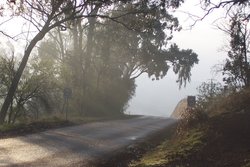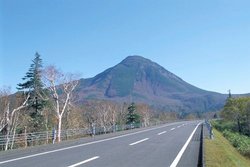Road
|
|
Missing image PompeiiStreet.jpg A Roman road in Pompeii |
A road is a strip of land, smoothed or otherwise prepared to allow easier travel, connecting two or more destinations.
In the context of railways, a road is a single track, which may be part of a multi-track system or may be an isolated line. In the context of sea transport, a road is an anchorage.
| Contents |
Usage and etymology
In original usage, a "road" was simply any pathway fit for riding ("road" is cognate with "ride", e.g.: ships ride at anchor in roads). The word “street,” whose origin is the Latin strata, was kept for paved pathways that had been prepared to ease travel in some way. Thus, many "Roman Roads" have the word "street" in their names.
However, modern usage does not usually make this distinction and it is only important since place names often hold the earlier usage in them; these days, roads are also prepared in some way. This includes, at the least, the removal of trees and smoothing of the ground. In some dialects, lower grade roads are called trails and wheel tracks, and it is uncertain where "road" begins and trail ends. Roads are a prerequisite for road transport of goods on wheeled vehicles.
The word “road” emphasizes its function of transportation along its length, while a “street” may be considered to have activity and commerce taking place on it (see street life).
History
Many historical examples exist of road and road-building. Some of the most famous are the Roman roads and the Incan courier roads. The oldest engineered road discovered is the Sweet Track causeway in England, dating from the 3800 BC. In ancient times, transport by river was far easier and faster than travel by road, especially considering the cost of road construction and the difference in carrying capacity between carts and river barges. A hybrid of road transport and ship transport is the historic horse-drawn boat.
During the industrial revolution, a development of the road was made: the railway. Today, roads are almost exclusively built to enable travel by car and other wheeled vehicles. In most countries, road transport is the most utilized way to move goods. Also, in most developed countries, roads are formally divided into lanes to ensure the safe and smooth movement of traffic.
Roads situated in cities are often, but not always, called streets or alleys; this reflects the historical fact that when they were first named there were more likely to be unmade roads in open country and paved roads in urban areas. This leads to roads being sometimes named from their destination or direction, while streets may be named from their location.
Road.ba.b777.arp.jpg
Funding
Road building and maintenance is one of the few areas of economic activity (compare military spending) that remain dominated by the public sector (though often through private contractors). Roads (except those on private property not accessible to the general public) are typically paid for by taxes (often raised through levies on fuel), though some public roads are funded by tolls.
Driving on the right or the left
Traffic drives, depending on the country, either on the right or on the left side of the road, see Rules of the road.
In countries where traffic drives on the right, traffic signs are mostly on the right side of the road, roundabouts (traffic circles) go counter-clockwise, and pedestrians crossing a two-way road should watch out for traffic from the left first. In countries where traffic drives on the left, the reverse is true.
Traffic flow and road design in both cases are each other's mirror image.
Design
Road design consists of two important technical aspects:
Besides these two technical sides of the design, environmental issues, planning issues and juridical issues are important.
Construction
Roads are built by removing vegetation (this may involve deforestation). The soil is tested to see if it will support weight and if not, a layer of soil is removed and replaced. The soil is compacted to form what is known as a "base course". On top of the base course is placed a wearing course which consists of asphalt concrete or concrete. While the main purpose of the wearing course is to prevent moisture from entering the road, for safety reasons this wearing course must be constructed to ensure adequate grip (and skid resistance) with vehicles.
Roads are constructed using a variety of road building equipment.
Modern roads, and indeed many ancient ones, such as those built by the Romans, feature a convex lateral surface known as camber. This is designed to allow water to drain away from the road to its edges. Water is then carried away by gutters to drains placed at intervals. Some roads don't have gutters and water simply drains away to a naturally porous verge, or into ditches. Modern roads that carry high speed traffic also employ camber in curves to aid traffic stability by allowing them to "bank into" the bend to some extent.
On the side of the road there may be retroreflectors on pegs, rocks or crash barriers, white toward the direction of the traffic on that side of the road, and red toward the other direction. In the road surface there may be cat's eyes: retroreflectors that protrude slightly, but which can be driven over without damage.
Road signs are often also made retroreflective. For greater visibility of road signs at daytime, sometimes fluorescence is applied to get very bright colors.
Maintenance
Like all outdoor structures, roads deteriorate over time. They may develop cracks or potholes, or be washed away altogether by floods. Cracks can be filled with various sealants and potholes can be filled with fresh asphalt, but eventually a whole new surface is needed.
Most European countries have strict standards for road construction that ensure that most roads can go 40 years or longer between resurfacings. The United States and many other countries have less stringent standards under which most roads last only 20 to 25 years.
Terminology
SandRoad.jpg
- arterial road
- asphalt (also called bitumen)
- autobahn
- autoroute
- autostrasse
- bottleneck
- boulevard
- cat's eye
- chicane
- concrete
- corduroy road
- corniche
- cul-de-sac
- curb extension
- expressway
- farm to market
- freeway
- green lane
- hard shoulder
- highway
- lane
- mountain pass
- milestone
- motorway
- pavement
- pavement markings
- pedestrian crossing
- performance
- plank road
- public road
- public space
- ranch road
- range road
- ridge road
- road number
- road safety
- road junction
- roadworks
- roundabout intersection
- rural route
- toll road
- traffic calming
- traffic circle
- traffic sign
- winter road
See also
External links
- List of countries where traffic drives on the left, as well as historical background. (http://www.2pass.co.uk/goodluck.htm)
- Which side of the road do they drive on? (http://www.travel-library.com/general/driving/drive_which_side.html)bg:Път
cs:Silnice da:Vej de:Straße fr:Route fy:Wei it:strada ja:道路 nl:weg no:Vei pl:Droga (komunikacja) pt:Estrada ro:Drum ru:Дорога simple:Road sl:Cesta sr:Пут sv:Väg fi:Tie zh:道路



